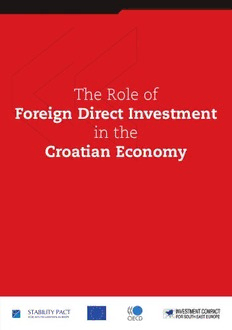
The role of foreign direct investment in the Croatian economy PDF
Preview The role of foreign direct investment in the Croatian economy
The Role of Foreign Direct Investment in the Croatian Economy The Role of Foreign Direct Investment in the Croatian Economy StudypreparedbyGáborHunya, theViennaInstituteforInternationalEconomicStudies, andAlenSkudar,CroatianNationalBank, fortheInvestmentCompactproject: ‘InvestmentandTradeLiberalisation,StrengtheningDevelopmentand ImplementationofInvestmentandTradePolicyintheWesternBalkans’ SupportedbytheEuropeanCommission2003CommunityAssistanceforReconstruction, DevelopmentandStabilisationProgramme TheRoleofForeignDirectInvestmentintheCroatianEconomy OrganisationforEconomicCo-operationandDevelopment The OECD is a unique forum where the governments of 30 democracies work together to address the economic,socialandenvironmentalchallengesofglobalisation.TheOECDisalsoattheforefrontofefforts tounderstandandtohelpgovernmentsrespondtonewdevelopmentsandconcerns,suchascorporate governance, the information economy and the challenges of an ageing population.The Organisation providesasettingwheregovernmentscancomparepolicyexperiences,seekanswerstocommonproblems, identifygoodpracticeandworktoco-ordinatedomesticandinternationalpolicies. The OECD member countries are: Australia,Austria, Belgium, Canada, the Czech Republic, Denmark, Finland,France,Germany,Greece,Hungary,Iceland,Ireland,Italy,Japan,Korea,Luxembourg,Mexico,the Netherlands, New Zealand, Norway, Poland, Portugal, the Slovak Republic, Spain, Sweden, Switzerland, Turkey,theUnitedKingdomandtheUnitedStates.TheCommissionoftheEuropeanCommunitiestakes partintheworkoftheOECD. InvestmentCompactforSouthEastEurope The Investment Compact for South East Europe (South East Europe Compact for Reform, Investment, IntegrityandGrowth)isaleadingprogrammedesignedtoimprovetheinvestmentclimateandtoencourage privatesectordevelopmentinSouthEastEurope(SEE).UndertheStabilityPactforSouthEasternEurope (WorkingTableIIonEconomicReconstruction,DevelopmentandCo-operation)andtheOECDDirectorate forFinancialandEnterpriseAffairs(www.oecd.org/daf),theprogrammehasitsowninstitutionalstructure includingaProjectTeamandanAnnualMinisterialConference. TheInvestmentCompactsupportsSEEwithpracticaltoolstoincreaseinvestment,growthandemployment andsupporttheEuropeanUnion(EU)integrationprocess. TheInvestmentCompactmembercountriesare:Albania,BosniaandHerzegovina,Bulgaria,Croatia,FYR Macedonia,Moldova,Montenegro,RomaniaandSerbia.TheworkoftheInvestmentCompactisactively supportedandfinancedbyAustria,Flanders(Belgium),theCzechRepublic,Ireland,Italy,Japan,Norway, Slovenia,Switzerland,theUnitedStatesandtheEuropeanCommission(www.investmentcompact.org). StabilityPactforSouthEasternEurope TheStabilityPactforSouthEasternEuropeisapoliticaldeclarationandframeworkagreementadoptedin June 1999 to encourage and strengthen co-operation among the countries of South East Europe and to facilitate, co-ordinate and streamline efforts to ensure stability and economic growth in the region (www.stabilitypact.org). ThisworkispublishedontheresponsibilityoftheSecretary-GeneraloftheOECD.Theopinionsexpressed andargumentsemployedhereindonotnecessarilyreflecttheofficialviewsoftheOrganisationorof thegovernmentsofitsmembercountries. ©OECD2007 Noreproduction,copy,transmissionortranslationofthispublicationmaybemadewithoutwrittenpermission.Applicationsshouldbe senttotheOECDInvestmentCompact(email:[email protected];fax:+33(0)145249335). 2 TheRoleofForeignDirectInvestmentintheCroatianEconomy Foreword Governmentpolicyisoneofthemostimportantfactorsinfluencingtheflowofforeigndirectinvestment (FDI).Therefore,countriesshouldensurethatmarketfriendlyinvestment-inducingpoliciesareproperly enacted.The objective of the Investment Compact, an initiative of the Stability Pact for South Eastern EuropeandtheOrganisationforEconomicCo-operationandDevelopment(OECD),istoassistthecountries ofSouthEastEurope(SEE)inimprovingtheinvestmentclimate. The OECD Investment Compact’s project, ‘Strengthening Development and Implementation of InvestmentandTradePolicyintheWesternBalkans’(hereinafterreferredtoasSEEStat)wasinitiatedto helpgovernmentsimprovetheirpoliciestoencouragemoreandbetterFDI.Thisprojectwasfundedbythe European Commission 2003 Community Assistance for Reconstruction, Development and Stabilisation (CARDS)Programme.TheSEEStatProjecthastwoobjectives.Thefirstistocoachcountriesonimproving the quality of their investment statistics,especially by ensuring that they are in line with international standards(i.e.IMF/OECDstandardsoncompilingFDIstatistics).Thesecondobjectiveinvolvesimproving theabilityofusersofFDIstatisticstoevaluatetheeconomicimpactofFDI. ThisstudywascommissionedtoassistinmeetingthesecondobjectivebyprovidingSEEcountrieswith acasestudyexampleofanevaluationofFDI’simpactontheCroatianeconomy.Itwaspreparedbythe Vienna Institute for International Economic Studies (wiiw), under the supervision of Gábor Hunya.An earlierdraftwaspresentedon30October2006inZagreb,Croatia,attheSEEStatworkshopon‘Evaluating theImpactofForeignDirectInvestmentintheWesternBalkans–CaseStudiesandPracticalTools,’where it was well-received.This workshop was attended by government officials, international organisations andindependentresearchorganisations,aswellasbytheDelegationoftheEuropeanCommissiontothe RepublicofCroatia.ItwasorganisedbytheInvestmentCompact,incollaborationwiththeCroatianMinistry ofEconomy,LabourandEntrepreneurshipandtheCroatianTradeandInvestmentPromotionAgency. ThisstudyisoneofaseriesofSEEStatpublications.TheothertitlesintheseriesareTheMetalProcessing IndustryinBosniaandHerzegovina:AStatisticalAssessmentandHowSouthEastEuropeanCountriesMeasureFDI. Theseriesalsoincludesaconceptpaper,HowtoAssesstheImpactofFDIonanEconomy. AnthonyO’Sullivan Head OECDInvestmentCompactforSouthEastEurope 3 TheRoleofForeignDirectInvestmentintheCroatianEconomy Table of Contents ListofAbbreviations.............................................................................................7 Acknowledgements..............................................................................................8 ExecutiveSummary .............................................................................................9 1 Introduction ..................................................................................................10 2 FDIinflow,dynamicsandcomposition....................................................................11 2.1 CharacteristicsofFDIinCroatia,asshownbyitsbalanceof paymentsandinternationalinvestmentposition...................................................11 2.1.1 FluctuatingFDIinflows.........................................................................11 2.1.2 SizeofinwardFDIstock ........................................................................11 2.1.3 FDIbycountryoforigin.........................................................................12 2.1.4 FDIinflowbyform ..............................................................................12 2.1.5 EquityFDIbymodeofentry....................................................................13 2.2 ImpactsoftheamountandstructureofFDI,andrelatedpolicyconclusions.....................15 3 Mainfeaturesofforeigninvestmententerprises(FIEs)inCroatia ......................................17 3.1 Datacoverageandmethodology .....................................................................17 3.2 FIEs’sharesintheCroatianeconomy................................................................18 3.3 Significanceofforeignownershipinmanufacturing–internationalcomparison................19 4 FDIimpactanalysis..........................................................................................21 4.1 ImpactofFDIonemployment........................................................................21 4.1.1 Croatianemploymentoverview................................................................21 4.1.2 Employmentdynamics .........................................................................22 4.1.3 Employmentingreenfieldandinprivatisation-related(M&A)FIEs .........................25 4.2 ImpactofFDIonfiscalrevenues .....................................................................27 4.3 ImpactofFDIonforeigntrade .......................................................................29 4.3.1 FDIandforeigntradeperformance............................................................29 4.3.2 TradebalanceofgreenfieldandM&AFIEs ....................................................30 4.3.3 ExportsalesstructureofFIEs...................................................................31 4.3.4 ConclusionsconcerningtheimpactofFDIonforeigntradeinCroatia......................34 Literature........................................................................................................36 Appendix1 TheCroatianFDIdatacompilationsystem...................................................38 A1 Introduction............................................................................................38 A2 Legalframework.......................................................................................38 A3 Methodology ...........................................................................................38 A4 Compilationpracticesanddatasources .............................................................39 A5 Datacollectionmethod................................................................................40 A6 Valuationofstocksandflows.........................................................................41 4 TheRoleofForeignDirectInvestmentintheCroatianEconomy A7 Specialissues ..........................................................................................41 A8 Datadissemination ...................................................................................43 A9 Debtor/creditorprinciple?.............................................................................43 A10 Conclusions ..........................................................................................43 Appendix2 TablesandGraphs...............................................................................44 Appendix3 ListofContacts...................................................................................53 List of Boxes Box1 DirectandIndirectEffectsofFDIonEmploymentinTransitionCountries..........................22 List ofTables Table1 FDIstockbycountryoforigin,end-2005 .............................................................12 Table2 ForeigndirectinvestmentinflowstoCroatia,byform(%) ..........................................12 Table3 FDIequityinvestment,bymodeofentry(%).........................................................13 Table4 CumulatedequityinflowsandearningsreinvestedintonewlyestablishedFIEs, 1993-2005:mostimportanteconomicactivities(EURmillion)......................................14 Table5 NumberofFIEswith10%or>50%foreignownershipandtotalnumberof registeredcompaniesintheFINAdatabase,1998-2004 .............................................17 Table6 SharesofFIEsintheCroatianeconomy,1998-2004(%)..............................................18 Table7 FIEs’sharesofemployment,salesandexportsinmanufacturingin selectedCEEcountries,2002(%) ......................................................................20 Table8 FIEs’shareofemploymentinmanufacturing: Bulgaria(2002),Croatia(2004)andRomania(2002)(%)..............................................21 Table9 TypesofemploymentchangeinmanufacturingintheVisegradcountries, EstoniaandCroatia....................................................................................24 Table10 TypesofemploymentchangeintheCroatianservicessector,1996-2000and2000-04..........24 Table11 M&AFIEstakenoverintheperiod1993-98:numberofcompaniesandemployees ............25 Table12 NewlyestablishedFIEs’shareoftotalcorporatetaxrevenuesandprofits(%)...................28 Table13 Numberofcompaniesreceivingtaxorcustomsdutybenefits,2001-05..........................28 Table14 NewlyestablishedFIEs’sharesintotalexportsandimports(%)..................................30 Table15 M&AFIEs’sharesoftotalexportsandimports,1996-2004(%).....................................31 Table16 Exports(totalandFIEs)byeconomicactivity,2004(HRKmillionand%) .........................32 Table17 Exportpropensity(exportsalesinsales)indomesticenterprises(DEs) andforeigninvestmententerprises(FIEs),2000and2004(%).....................................33 Table18 Distributionofexportsalesbyindustries’technologylevels:Croatia(2004), Slovenia(2001)andBulgaria(2003)(%)..............................................................33 Table19 Exportpropensity(exportsalesinsales)inCroatia, SloveniaandBulgariabyeconomicactivities(%)...................................................35 TableA1 OECDclassificationofmanufacturingindustries,basedontechnology .........................44 TableA2 ComparisonoftheFIEanddomesticsectors,FIE/DE(%)..........................................45 5 TheRoleofForeignDirectInvestmentintheCroatianEconomy Table of Contents TableA3 Employmentchange,1996-2004(%)andFIEs’shareofemployment ineacheconomicactivity,2004(%)..................................................................50 TableA4 Changeinnumberofemployeesandtypeofchange (totaleconomyandFIEs),1996-2000and2000-04..................................................51 TableA5 NumberofjobscreatedbynewlyestablishedFIEs,1996-2004, andshareoftotalemployment,2004(%)...........................................................52 List of Figures Figure1 ForeigndirectinvestmentflowsintoCroatia(EURmillion)........................................11 Figure2 CumulatedFDIequityandreinvestmentinflowsintonewandoldcompanies byeconomicactivity,2003-05(%)....................................................................14 Figure3 EmploymentdynamicsforM&AFIEs,t(yearofM&A)=100.......................................26 Figure4 EmploymentchangeinnewlyestablishedandM&AFIEs,3-6yearsfollowing theirestablishmentoracquisition(%)...............................................................27 FigureA1 Distributionofsalesbymainactivities(%) .......................................................46 FigureA2 Shareofsalesbyeconomicactivities,2004(%)....................................................47 FigureA3 FIEsalesbyeconomicactivities,1998and2004(%) ..............................................48 FigureA4 FIEs’shareofsalesbyeconomicactivity,1998and2004(%) .....................................49 6 TheRoleofForeignDirectInvestmentintheCroatianEconomy List of Abbreviations BOP Balanceofpayments BPM BalanceofPaymentsmanual CNB CroatianNationalBank COPC Currentoperatingperformanceconcept DE Domesticenterprise EU EuropeanUnion FDI Foreigndirectinvestment FIE Foreigninvestmententerprise FINA FinancialAgency GDP Grossdomesticproduct IMF InternationalMonetaryFund INA IndustrijaNafted.d. ISIC InternationalStandardIndustrialClassification ITRS InternationalTransactionsRecordingSystem M&A Mergersandacquisitions MOL MagyarOlaj-ésGázipariRészvénytársaság(HungarianOil&GasCompanyPlc.) NACE NomenclatureGénéraledesActivitiésEconomiquesdansl’UnionEuropéenne (GeneralNomenclatureforEconomicActivitiesintheEuropeanUnion) NMS NewEUMemberState OECD OrganisationforEconomicCo-operationandDevelopment SDDS SpecialDataDisseminationStandard SEEC SouthEastEuropeancountry SPE Specialpurposeentity wiiw WienerInstitutfürInternationaleWirtschaftsvergleiche (ViennaInstituteforInternationalEconomicStudies) 7 TheRoleofForeignDirectInvestmentintheCroatianEconomy Acknowledgements ThisreporthasbeenpreparedbyGáborHunya Thereporthasbenefitedfromcommentsand oftheViennaInstituteforInternationalEconomic contributions by Antonio Fanelli (Deputy Head, Studies (wiiw) and Alen Skudar of the Croatian Investment Compact) and Erin Hengel (Policy National Bank.It was commissioned by the OECD Analyst,InvestmentCompact).Thefinalreportwas Investment Compact as part of the European editedandpreparedforpublicationbyJohnSmith, Commission 2003 CARDS funded project, GeorgianaPopandErinHengel. ‘StrengtheningDevelopmentandImplementationof InvestmentandTradePolicyintheWesternBalkans’ (SEEStat). 8 TheRoleofForeignDirectInvestmentintheCroatianEconomy Executive Summary Thepurposeofthisstudyistoassesstherole acquired (privatised) companies in the first years of foreign direct investment (FDI) in Croatia.The afteracquisition.Subsequently,itbegantorise.This main characteristics of FDI in that country are corroborates conventional wisdom, whereby described,alongwithitsimpactsonemployment, companiesundergoarestructuringphasefollowing fiscalrevenuesandtrade. privatisation and shed labour; later, with the increased productivity and improved The study first looks at Croatia’s balance of competitiveness brought about by restructuring, payments statistics, compiled by the Croatian employmentincreases. National Bank. Croatia has attracted a relatively significantamountofFDI,especiallywhenFDIper Impactonfiscalrevenues.Taxincentivesintended capita statistics are compared with those of its toattractgreenfieldFDIhavehadlittleimpactonthe neighbours.Reinvestedearningsasapercentageof statebudget.Thiscanprobablybeattributedtothe FDI have also increased in the past few years. generally small size of greenfield foreign However, most FDI has been concentrated in the investments.Croatia,whichhasaratherlimitedtax services sector, especially financial services and incentive scheme, provides no direct investment retailandwholesaletrade,reflectingforeigninvestor subsidies. interest in the domestic market. Moreover, while greenfieldFDIwashigherthanacquisition-related Impactontrade.GreenfieldFDIhasexacerbated FDIin2003-05,only10%ofmanufacturingFDIwas the current account deficit, largely due to its greenfield. concentration in the services sector and general absence from the more export-oriented TheimpactofFDIinCroatiaonemployment, manufacturing sector. However, the many fiscalrevenuesandtradeisthenexplored,usinga privatisations in the manufacturing sector in the databaseofallofthecountry’slegalentities(except late 1990s served to mitigate the current account banks and insurance companies) compiled by the deficit. Privatisation-related FDI has had a much CroatianNationalFinancialAgency(FINA).Themain morelimitedupgradingeffectontheforeigntrade findingsareasfollows: structureinCroatiathaninotherCentralEuropean transitioncountries.Overall,FDIhasnotimproved Impact on employment. Conclusive evidence access to foreign markets, although this has also concerningtheimpactofFDIonemploymentdoes limited the replacement of domestic sourcing by not exist. Employment generally fell at foreign foreignsuppliers. 9
